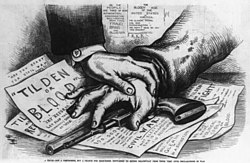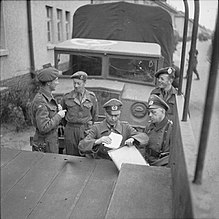Ceasefire

By Thomas Nast in Harper's Weekly, February 17, 1877, p. 132.
A ceasefire (or truce), also spelled cease fire (the antonym of 'open fire'[1]), is a temporary stoppage of a war in which each side agrees with the other to suspend aggressive actions.[2] Historically, the concept existed at least by the time of the Middle Ages, when it was known as a 'truce of God'.[3] Ceasefires can be declared as a humanitarian gesture,[4] be preliminary, i.e., prior to a political agreement, or definitive, i.e., with the intention of resolving a conflict.[5] Ceasefires may be declared as part of a formal treaty, but they have also been called as part of an informal understanding between opposing forces.[1]
Ceasefires may be between state actors or involve non-state actors.[6] They may be formal (usually written), or informal; their conditions may be public or secret. Ceasefires may occur via mediation or otherwise as part of a peace process or be imposed by United Nations Security Council resolutions via Chapter VII of the United Nations Charter.[1]
A ceasefire is usually more limited than a broader armistice, which is a formal agreement to end fighting. Ceasefires may be abused by parties as cover to re-arm or reposition forces,[1][6] and they typically fail, when they are referred to as 'failed ceasefires';[7] however, successful ceasefires may be followed by armistices and then by peace treaties.
The durability of ceasefire agreements is affected by several factors, such as demilitarized zones, withdrawal of troops and third-party guarantees and monitoring (e.g. peacekeeping). Ceasefire agreements are more likely to be durable when they reduce incentives to attack, reduce uncertainty about the adversary's intentions, and when mechanisms are put in place to prevent and control accidents from developing into conflict.[2]
Historical examples[]
World War I[]
During World War I, on December 24, 1914, there was an official ceasefire on the Western Front as France, the United Kingdom, and Germany observed Christmas. There are accounts that claimed the unofficial ceasefire took place throughout the week leading to Christmas, and that British and German troops exchanged seasonal greetings and songs between their trenches.[8] The ceasefire was brief but spontaneous. Beginning when German soldiers lit Christmas trees, it quickly spread up and down the Western Front.[9] One account described the development in the following words:
It was good to see the human spirit prevailed amongst all sides at the front, the sharing and fraternity. All was well until the higher echelons of command got to hear about the effect of the ceasefire, whereby their wrath ensured a return to hostilities.[10]
There was no peace treaty signed during the Christmas truce, and the war resumed after a few days.

Korean War[]
On November 29, 1952, the US president-elect, Dwight D. Eisenhower, went to Korea to see how to end the Korean War. With the UN's acceptance of India's proposed armistice, the ceasefire of the Korean People's Army (KPA), the People's Volunteer Army (PVA), and the UN Command had the battle line approximately at the 38th parallel north. These parties signed the Korean Armistice Agreement on July 27, 1953, to end the fighting.[11][12] South Korean President Syngman Rhee attacked the peace proceedings and did not sign the armistice.[13] Upon agreeing to the ceasefire agreement, which called upon the governments of South Korea, North Korea, China, and the United States to participate in continued peace talks. The principal belligerents established the Korean Demilitarized Zone (DMZ), which has since been patrolled by the KPA and the joint Republic of Korea Army, US, and UN Command. The war is considered to have ended at that point even though there still is no peace treaty.
Vietnam War[]
On New Years Day, 1968, Pope Paul VI convinced South Vietnam and the United States to declare a 24-hour-truce. However, the Viet Cong and North Vietnam did not adhere to the truce, and ambushed the 2nd Battalion, Republic of Vietnam Marine Division, 10 minutes after midnight in Mỹ Tho. The Viet Cong would also attack a U.S. Army fire support base near Saigon, causing more casualties.[14]
On January 15, 1973, US President Richard Nixon ordered a ceasefire of the aerial bombings in North Vietnam. The decision came after Henry Kissinger, the National Security Advisor to the President, returned to Washington, DC, from Paris, France, with a draft peace proposal. Combat missions continued in South Vietnam. By January 27, 1973, all parties of the Vietnam War signed a ceasefire as a prelude to the Paris Peace Accord.
Gulf War[]
After Iraq was driven out of Kuwait by US-led coalition forces during Operation Desert Storm, Iraq and the UN Security Council signed a ceasefire agreement on March 3, 1991.[15] Subsequently, throughout the 1990s, the U.N. Security Council passed numerous resolutions calling for Iraq to disarm its weapons of mass destruction unconditionally and immediately. Because no peace treaty was signed after the Gulf War, the war still remained in effect, including an alleged assassination attempt of former US President George H. W. Bush by Iraqi agents while on a visit to Kuwait;[16] Iraq being bombed in June 1993 as a response, Iraqi forces firing on coalition aircraft patrolling the Iraqi no-fly zones, US President Bill Clinton's bombing of Baghdad in 1998 during Operation Desert Fox, and an earlier 1996 bombing of Iraq by the US during Operation Desert Strike. The war remained in effect until 2003, when US and UK forces invaded Iraq and toppled Saddam Hussein's regime from power.
Kashmir conflict[]
A UN-mediated ceasefire was agreed between India and Pakistan, on 1 January 1949, ending the Indo-Pakistani War of 1947 (also called the 1947 Kashmir War). Fighting broke out between the two newly independent countries in Kashmir in October 1947, with India intervening on behalf of the princely ruler of Kashmir, who had joined India, and Pakistan supporting the rebels. The fighting was limited to Kashmir, but, apprehensive that it might develop into a full-scale international war, India referred the matter to the UN Security Council under Article 35 of the UN Charter, which addresses situations "likely to endanger the maintenance of international peace". The Security Council set up the dedicated United Nations Commission for India and Pakistan, which mediated for an entire year as the fighting continued. After several UN resolutions outlining a procedure for resolving the dispute via a plebiscite, a ceasefire agreement was reached between the countries towards the end of December 1948, which came into effect in the New Year. The Security Council set up the United Nations Military Observer Group for India and Pakistan (UNMOGIP) to monitor the ceasefire line.[17] India declared a ceasefire in Kashmir Valley during Ramadan in 2018.[18]
Israeli–Palestinian conflict[]
An example of a ceasefire in the Israeli–Palestinian conflict was announced between Israel and the Palestinian National Authority on February 8, 2005. When announced, chief Palestinian negotiator Saeb Erekat publicly defined the ceasefire as follows: "We have agreed that today President Mahmoud Abbas will declare a full cessation of violence against Israelis anywhere and Prime Minister Ariel Sharon will declare a full cessation of violence and military activities against Palestinians anywhere."[19]
Syrian Civil War[]
Several attempts have been made to broker ceasefires in the Syrian Civil War.[20]
2020 global ceasefire[]
The 2020 global ceasefire was a response to a formal appeal by United Nations Secretary-General António Manuel de Oliveira Guterres on March 23 for a global ceasefire as part of the United Nations' response to the COVID-19 coronavirus pandemic. On 24 June, 2020, 170 UN Member States and Observers signed a non-binding statement in support of the appeal, rising to 172 on 25 June, 2020, and on 1 July 2020, the UN Security Council passed a resolution demanding a general and immediate global cessation of hostilities for at least 90 days.[21][22]
See also[]
- 2020 Nagorno-Karabakh ceasefire agreement
- Armistice
- Ekecheiria – Olympic Truce
- Korean Armistice Agreement
- Peacemaking
- Peace process
- Peace treaty
References[]
- ^ a b c d Forster, Robert A. (2019), "Ceasefires", in Romaniuk, Scott; Thapa, Manish; Marton, Péter (eds.), The Palgrave Encyclopedia of Global Security Studies, Cham: Springer International Publishing, pp. 1–8, doi:10.1007/978-3-319-74336-3_8-2, ISBN 978-3-319-74336-3, S2CID 239326729
- ^ a b Fortna, Virginia Page (2004). Peace Time: Cease-Fire Agreements and the Durability of Peace. Princeton University Press. ISBN 978-0-691-18795-2. OCLC 1044838807.
- ^ Bailey, Sydney D. (1977). "Cease-Fires, Truces, and Armistices in the Practice of the UN Security Council". The American Journal of International Law. 71 (3): 461–473. doi:10.2307/2200012. ISSN 0002-9300. JSTOR 2200012. S2CID 147435735.
- ^ Hay, Robin. (1990). Humanitarian ceasefires : an examination of their potential contribution to the resolution of conflict. L'Institut. ISBN 0-662-18140-9. OCLC 300422008.
- ^ "Evaluating the Relevance of Ceasefires in Light of the UN Global Ceasefire Quandary". Modern Diplomacy. 2020-07-17. Retrieved 2020-08-01.
- ^ a b Sosnowski, Marika (2020-03-03). "Ceasefires as violent state-building: local truce and reconciliation agreements in the Syrian civil war". Conflict, Security & Development. 20 (2): 273–292. doi:10.1080/14678802.2019.1679561. ISSN 1467-8802. S2CID 213876558.
- ^ Sagård, Tora (2019). Causes of Ceasefire Failure: A survival analysis, 1989-2017 (PDF). Oslo: Peace Research Institute Oslo.
- ^ Evans, Abigail; Bartollas, Clemens; Graham, Gordon; Henke, Kenneth (2011). The Long Shadow of Emile Cailliet: Faith, Philosophy, and Theological Education. Eugene, OR: Wipf and Stock Publishers. ISBN 9781610971126.
- ^ Brockell, Gillian (December 24, 2017). "The Christmas Truce miracle: Soldiers put down their guns to sing carols and drink wine". Washington Post. Retrieved 2018-08-27.
- ^ Wilson, Ross (2016). Cultural Heritage of the Great War in Britain. Oxon: Routledge. p. 74. ISBN 9781409445739.
- ^ "Document for July 27th: Armistice Agreement for the Restoration of the South Korean State". Archived from the original on 19 October 2012. Retrieved 13 December 2012.
- ^ "Korean War Armistice Agreement". FindLaw. Canada and United States: Thomson Reuters. 27 July 1953. Archived from the original on 5 March 2014. Retrieved 5 March 2014.
- ^ Kollontai, Ms Pauline; Kim, Professor Sebastian C. H.; Hoyland, Revd Greg (2013-05-28). Peace and Reconciliation: In Search of Shared Identity. Ashgate Publishing, Ltd. p. 111. ISBN 978-1-4094-7798-3.
- ^ Kurlansky, Mark. (2004). 1968 : the year that rocked the world (1st ed.). New York: Ballantine. pp. 3, 13. ISBN 0-345-45581-9. OCLC 53929433.
- ^ "BBC News | Saddam's Iraq: Key events". news.bbc.co.uk. Retrieved 2020-08-01.
- ^ , Wikipedia, 2020-07-27, retrieved 2020-08-01
- ^ Schofield, Victoria (2003) [First published in 2000], Kashmir in Conflict, London and New York: I. B. Taurus & Co, pp. 68–69, ISBN 978-1860648984
- ^ "India declares ceasefire in Kashmir - Global Village Space". Global Village Space. 2018-05-17. Retrieved 2018-05-18.
- ^ Wedeman, Ben; Raz, Guy; Koppel, Andrea (2005-02-07). "Mideast cease-fire expected Tuesday". CNN. Retrieved 2007-01-03.
- ^ Lundgren, Magnus (2016). "Mediation in Syria: initiatives, strategies, and obstacles, 2011–2016". Contemporary Security Policy. 37 (2): 273–288. doi:10.1080/13523260.2016.1192377. S2CID 156447200.
- ^ "S/RES/2532(2020) - E - S/RES/2532(2020)". undocs.org. Retrieved 2020-08-01.
- ^ "Stalled Security Council resolution adopted, backing UN's global humanitarian ceasefire call". UN News. 2020-07-01. Retrieved 2020-08-01.
Further reading[]
- Akebo, Malin. (2016). Ceasefire Agreements and Peace Processes: A Comparative Study. Routledge.
- Colletta, Nat. (2011). Mediating ceasefires and cessations of hostilities agreements in the framework of peace processes. In Peacemaking: From Practice to Theory. Praeger, 135–147.
- Forster, Robert A. (2019). Ceasefires. In The Palgrave Encyclopedia of Global Security Studies. Palgrave.
- Fortna, Virginia Page. (2004). Peace Time: Cease-fire Agreements and the Durability of Peace. Princeton University Press.
- Sosnowski, Marika. (2019). Ceasefires as State-Building. Program on Governance and Local Development Working Paper No. 22. University of Gothenburg.
- Williams, R., Gustafson, D., Gent, S., & Crescenzi, M. (2021). "A latent variable approach to measuring and explaining peace agreement strength." Political Science Research and Methods, 9(1), 89-105.
External links[]
| Look up ceasefire or truce in Wiktionary, the free dictionary. |
- Military diplomacy
- Ceasefires
- Military strategy
- Peace mechanisms